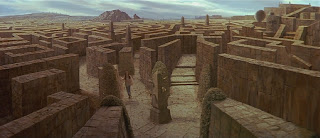 |
| نواعير حماه |
A noria (Arabic: ناعورة, nā‘ūra, from Syriac: ܢܥܘܪܐ, nā‘urā) is a machine for lifting water into a small aqueduct, either for the purpose of irrigation or, in at least one known instance, to feed seawater into a saltern.
There are three types of noria. The most common examples consist of a vertical wheel which is slung with a chain of buckets. The buckets hang down into a well which may be up to 8 m (26 ft) deep. The most primitive norias of this type are driven by donkeys, mules, or oxen. The animal turns another wheel, which is engaged with the noria and so causes it to turn. This causes the buckets to circulate.
A second type of noria uses the same system, of a necklace of clay or wooden buckets, but it is driven by the wind. The wind driven norias in the vicinity of Cartagena, Spain, are virtually identical in appearance with the local grinding mills.
The third type of noria uses the energy derived from the flow of a river. It consists of a large, very narrow undershot waterwheel whose rim is made up of a series of containers which lift water from the river to a very small aqueduct at the top of the wheel. Unlike the water wheels found in mills, a noria does not provide mechanical power to any other process. Its concept is similar to the modern hydraulic ram, which also uses the power of flowing water to pump some of the water out of the river.[1]
A few norias were hybrids, consisting of an animal-driven waterwheel.
A noria can raise water to somewhat less than its full height. The largest noria in the world, with a diameter of about 20 meters, is located in the Syrian city of Hama.
It performs a similar function to chain pumps (including the saqiya), and other pumps, that of moving water from a lower elevation to that of a higher elevation, but these are generally powered by other means, not by a waterwheel).
Sound of a noria
صوت الناعورة
http://upload.wikimedia.org/wikipedia/commons/e/e6/Hama-sound_of_noria.ogg




